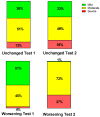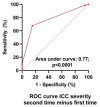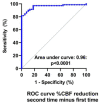Worsening Symptoms Is Associated with Larger Cerebral Blood Flow Abnormalities during Tilt-Testing in Myalgic Encephalomyelitis/Chronic Fatigue Syndrome (ME/CFS)
- PMID: 38138257
- PMCID: PMC10744908
- DOI: 10.3390/medicina59122153
Worsening Symptoms Is Associated with Larger Cerebral Blood Flow Abnormalities during Tilt-Testing in Myalgic Encephalomyelitis/Chronic Fatigue Syndrome (ME/CFS)
Abstract
Background and Objectives: During tilt testing, myalgic encephalomyelitis/chronic fatigue syndrome (ME/CFS) patients experience an abnormal reduction in cerebral blood flow (CBF). The relationship between this CBF reduction and symptom severity has not been examined in detail. Our hypothesis was that ME/CFS severity is related to the degree of the CBF reduction during tilt testing. Materials and Methods: First, from our database, we selected ME/CFS patients who had undergone assessments of ME/CFS symptomatology and tilt tests on the same day, one at the first visit and the second during a follow-up. The change in symptomatology was related to the change in CBF during the tilt test. Second, we combined the data of two previously published studies (n = 219), where disease severity as defined by the 2011 international consensus criteria (ICC) was available but not published. Results: 71 patients were retested because of worsening symptoms. The ICC disease severity distribution (mild-moderate-severe) changed from 51/45/4% at visit-1 to 1/72/27% at follow-up (p < 0.0001). The %CBF reduction changed from initially 19% to 31% at follow-up (p < 0.0001). Of 39 patients with stable disease, the severity distribution was similar at visit-1 (36/51/13%) and at follow-up (33/49/18%), p = ns. The %CBF reduction remained unchanged: both 24%, p = ns. The combined data of the two previously published studies showed that patients with mild, moderate, and severe disease had %CBF reductions of 25, 29, and 33%, respectively (p < 0.0001). Conclusions: Disease severity and %CBF reduction during tilt testing are highly associated in ME/CFS: a more severe disease is related to a larger %CBF reduction. The data suggest a causal relationship where a larger CBF reduction leads to worsening symptoms.
Keywords: ME/CFS; cardiac index; cerebral blood flow; disease severity; orthostatic intolerance; stroke volume index; symptom worsening; tilt-table testing.
Conflict of interest statement
The authors declare no conflict of interest.
Figures







Similar articles
-
Cerebral blood flow remains reduced after tilt testing in myalgic encephalomyelitis/chronic fatigue syndrome patients.Clin Neurophysiol Pract. 2021 Sep 23;6:245-255. doi: 10.1016/j.cnp.2021.09.001. eCollection 2021. Clin Neurophysiol Pract. 2021. PMID: 34667909 Free PMC article.
-
Orthostatic Symptoms and Reductions in Cerebral Blood Flow in Long-Haul COVID-19 Patients: Similarities with Myalgic Encephalomyelitis/Chronic Fatigue Syndrome.Medicina (Kaunas). 2021 Dec 24;58(1):28. doi: 10.3390/medicina58010028. Medicina (Kaunas). 2021. PMID: 35056336 Free PMC article.
-
Reductions in Cerebral Blood Flow Can Be Provoked by Sitting in Severe Myalgic Encephalomyelitis/Chronic Fatigue Syndrome Patients.Healthcare (Basel). 2020 Oct 11;8(4):394. doi: 10.3390/healthcare8040394. Healthcare (Basel). 2020. PMID: 33050553 Free PMC article.
-
Cardiovascular and haematological pathology in myalgic encephalomyelitis/chronic fatigue syndrome (ME/CFS): A role for viruses.Blood Rev. 2023 Jul;60:101075. doi: 10.1016/j.blre.2023.101075. Epub 2023 Mar 20. Blood Rev. 2023. PMID: 36963989 Free PMC article. Review.
-
Review of case definitions for myalgic encephalomyelitis/chronic fatigue syndrome (ME/CFS).J Transl Med. 2020 Jul 29;18(1):289. doi: 10.1186/s12967-020-02455-0. J Transl Med. 2020. PMID: 32727489 Free PMC article. Review.
Cited by
-
Long COVID Is Not a Functional Neurologic Disorder.J Pers Med. 2024 Jul 29;14(8):799. doi: 10.3390/jpm14080799. J Pers Med. 2024. PMID: 39201991 Free PMC article. Review.
-
Why the Psychosomatic View on Myalgic Encephalomyelitis/Chronic Fatigue Syndrome Is Inconsistent with Current Evidence and Harmful to Patients.Medicina (Kaunas). 2023 Dec 31;60(1):83. doi: 10.3390/medicina60010083. Medicina (Kaunas). 2023. PMID: 38256344 Free PMC article.
-
The Cardiac Output-Cerebral Blood Flow Relationship Is Abnormal in Most Myalgic Encephalomyelitis/Chronic Fatigue Syndrome Patients with a Normal Heart Rate and Blood Pressure Response During a Tilt Test.Healthcare (Basel). 2024 Dec 20;12(24):2566. doi: 10.3390/healthcare12242566. Healthcare (Basel). 2024. PMID: 39765993 Free PMC article.
-
Cardiopulmonary and metabolic responses during a 2-day CPET in myalgic encephalomyelitis/chronic fatigue syndrome: translating reduced oxygen consumption to impairment status to treatment considerations.J Transl Med. 2024 Jul 5;22(1):627. doi: 10.1186/s12967-024-05410-5. J Transl Med. 2024. PMID: 38965566 Free PMC article.
-
Impaired Hand Grip Strength Correlates with Greater Disability and Symptom Severity in Post-COVID Myalgic Encephalomyelitis/Chronic Fatigue Syndrome.J Clin Med. 2024 Apr 8;13(7):2153. doi: 10.3390/jcm13072153. J Clin Med. 2024. PMID: 38610918 Free PMC article.
References
-
- Carruthers B.M., van de Sande M.I., Meirleir K.L.D.E., Klimas N.G., Broderick G., Mitchell T., Staines D., Powles A.C., Speight N., Vallings R., et al. Myalgic encephalomyelitis: International consensus criteria. J. Intern. Med. 2011;270:327–338. doi: 10.1111/j.1365-2796.2011.02428.x. - DOI - PMC - PubMed
-
- Institute of Medicine (IOM) Beyond Mayalgic Encephalomyelitis/Chronic Fatigue Syndrome: Redefining an Illness. The National Academies Press; Washington, DC, USA: 2015. - PubMed
MeSH terms
LinkOut - more resources
Full Text Sources
Medical
Miscellaneous

